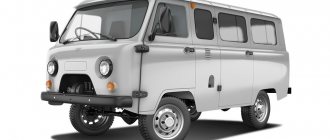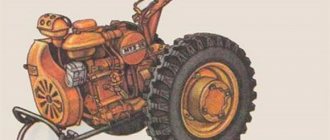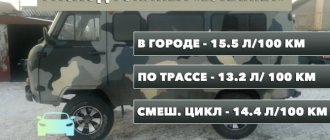Cars for sale
UAZ Bukhanka, 2007
UAZ Pickup, 2012
UAZ Patriot, 2019
UAZ Bukhanka, 1975
Comments 21
So which one did you go on?
mostly 5, sometimes through the population. points 4, there are 6 villages in total
On which of the two UAZs
It’s clear that the liquidator was sold long ago and left it for people’s information, but I didn’t understand it right away
cool, on such slippers and such consumption as a foreign car
not now there are ateshki 265 70 16
For the first time, when I decided to travel a little on a tadpole, go for a nut, I didn’t know how many kilometers, what kind of road it was, we decided to play it safe, filled one full tank, and another 15 liters into a canister. In the end, it was a total of 120 km one way, 15-20 km of which were climbing, a total of about 1 km of the way at the end was mud, sometimes the front end turned on. As a result, it was 240 km back and forth, it consumed a little more, a little less than half a tank (the tank is 53 liters), measured by dipping a hose, because the sensors from the factory both lie. It turned out to be about 11-12 liters per 100 km. Then these 15 liters were poured into the tank. As a result, I returned with an almost full tank of gasoline, about ten liters. Another time I also went on a trip, the road was ordinary, half dirt, half asphalt, but well-trodden. I drove about 400 km without burning out the tank. Without the awning, the consumption would be even less. On 2 full tanks you can travel a little less than 1000 km. Since then, fuel consumption has stopped worrying me, because the UAZ consumes gasoline quite economically, given its low speed.
Well, you generally have a sniff compared to me, but after 30 out of a hundred it makes me very happy
Perhaps because I don’t like to push the pedal, I smoothly accelerated to 80 km/h, and felt sick in 4th gear, at medium speeds. Do you have a carburetor or an injector?
409 euros 4, changed 2 months ago with a five-speed gearbox
MegaTurboGT1500
For the first time, when I decided to travel a little on a tadpole, go for a nut, I didn’t know how many kilometers, what kind of road it was, we decided to play it safe, filled one full tank, and another 15 liters into a canister. In the end, it was a total of 120 km one way, 15-20 km of which were climbing, a total of about 1 km of the way at the end was mud, sometimes the front end turned on. As a result, it was 240 km back and forth, it consumed a little more, a little less than half a tank (the tank is 53 liters), measured by dipping a hose, because the sensors from the factory both lie. It turned out to be about 11-12 liters per 100 km. Then these 15 liters were poured into the tank. As a result, I returned with an almost full tank of gasoline, about ten liters. Another time I also went on a trip, the road was ordinary, half dirt, half asphalt, but well-trodden. I drove about 400 km without burning out the tank. Without the awning, the consumption would be even less. On 2 full tanks you can travel a little less than 1000 km. Since then, fuel consumption has stopped worrying me, because the UAZ consumes gasoline quite economically, given its low speed.
I had 40 liters enough for about 250 km on asphalt. carb 151
UAZ 3303 2.7 MT – fuel consumption per 100 km
- City cycle: 12.4 l
- Extra-urban cycle: 9.6 l
- Combined cycle: 10.9 l
UAZ 3303 is a small all-wheel drive domestic truck, which was produced in Ulyanovsk at the automobile plant for the first time in 1985. The car's cabin, made of metal, has no hood and is located above the engine. There are two seats in the cabin; the seats can be easily removed if necessary. One of the advantages of the car is its fairly large windshield. Manually lowering side windows.
The petrol engine has a volume of 2.7 liters and a power of 112 hp. Five-speed manual transmission. The truck is simple and unpretentious in maintenance, which attracts car enthusiasts. Also, a UAZ can easily drive where a passenger car or even any other SUV cannot.
Another advantage of this model is its very large load capacity - about 1200 kg. This truck is like an ant, capable of lifting a load that weighs almost ten times the weight of the car itself. The engine is located directly in the cabin, which makes it possible to repair the car even in cold weather without going outside.
“Loaf”, as the car is popularly called, is in great demand because it is most often used as an ambulance or police car. A reliable car, the quality and cross-country ability of which can be the envy of many imported SUVs. For such a device, the price is quite low when compared with other machines of this type. Thus, we can summarize: a domestic car with very high cross-country ability, there are no arguments regarding maintenance, reviews from car enthusiasts are particularly positive.
Source
UAZ Simbir
In 1999, the design department of the Ulyanovsk Automobile Plant came up with the idea of taking the popular wheelbase from the 3160 model and increasing it by a significant 360 millimeters. The result of this experiment was the appearance of the UAZ-3162 Simbir SUV. By increasing the wheelbase parameter, the company's representatives achieved a chic effect - the new product did not look like an “ugly duckling” in the family of cars.
It was immediately decided to put the new model into production. And just a few years later, Simbir became a full-fledged replacement for its predecessor with a short platform.
| Engine | Consumption (city) | Consumption (highway) | Flow (mixed) | Fuel type |
| 2.7 MT 128 hp (Mechanics) | — | — | 10,4 | Petrol |
It is worth noting that the spring of 1956 was marked for the Ulyanovsk Automobile Plant with an order to carry out design work that would make it possible to create completely new cars. Among them were supposed to appear cargo and medical transport, a minibus, and also a van. The design department managed to develop a technology that had not previously been used by any automaker, which implied the location of the cabin above the engine. This made it possible to significantly increase the volume of the body while keeping the length of the car at the same level.
In the summer of 1985, the company carried out modernization for the first time: all models changed their indices, larger lights were installed, a separate brake system appeared, the hydraulic clutch drive was significantly lighter, a heater with greater power was installed in the cars, as well as an anti-dazzle rear view mirror.
Currently, UAZ continues to develop its own automobile line, introducing new models to consumers almost every year. It is worth noting that in 2013 the company managed to increase export volumes by a third, thereby demonstrating the high quality of its products.
UAZ-3303: technical characteristics
The second generation of “tadpole”, stepping into the 21st century
The indestructible record holders and “long-livers” of the domestic automobile industry are the classic cars of the Ulyanovsk Automobile and “Tadpole”. "Tadpole" UAZ-3303 is a light-duty 4x4 off-road truck. In 1985, it replaced the previous “tadpole” truck, which had been mass-produced since 1966 (UA3-450D, UA3-452D). They are still produced today: these are modifications of the UAZ-330394 and UAZ-330364 with the ZMZ-40 engine.” Initially, its standard carrying capacity was defined as 0.8 tons. Now it has been increased to 1.225 tons.
Fuel consumption rate for UAZ trucks
Fuel consumption for UAZ trucks and road trains in accordance with the fuel consumption rate per 100 km is calculated using the formula:
Qн = 0.01 x (Hsan x S + Hw x W) x (1 + 0.01 x D)
where Qн is the standard UAZ fuel consumption per 100 km, l; S —mileage of a car or road train, km; Hsan is the fuel consumption rate per mileage of a UAZ vehicle or road train in running order without load;
Secrets of “longevity” in the domestic market
Having opened an archival article from the magazine “Behind the Wheel” from 1965, timed to coincide with the start of serial production of UAZ light-tonnage trucks, we learn that these delivery vehicles were designed to free Soviet medium-tonnage trucks from working with half or even a third of the body filled, and thereby contribute to savings folk remedies. Today, UAZ trucks find their main use not in cities, but in the outback, off-road. This is their “element”, where modern trucks cannot compare with them in cross-country ability.
The secrets of the popularity of the UAZ-3303 lie in the following factors:
- Simplicity of design, which allows you to show excellent technical characteristics, regardless of operating conditions. The design of the machine is not only simple, but also has the highest strength and wear resistance.
- High maneuverability and very compact dimensions; For a car of this class, category “C” is not required; “passenger” category “B” is sufficient.
- Excellent visibility (due to the wide and voluminous windshield, and also due to the fact that the truck cabin is wider than the body).
- Unpretentiousness; accessibility and ease of maintenance and repair.
- Convenient loading platform that can easily accommodate four Euro pallets of standard size 800 x 1200 mm.
- Connectable all-wheel drive with three operating modes: economical rear-wheel drive; all-wheel drive; all-wheel drive with reduction gears.
All these positive qualities of the UAZ-3303, of course, matter. But the truly decisive ones for potential buyers are the following:
- Affordable price of the car itself and spare parts for it.
- Excellent cross-country ability in any, even the most difficult road conditions.
That is why, despite being more than half a century old, classic light-duty commercial vehicles from Ulyanovsk continue to be in stable demand. If in the city their use hardly makes sense - there are many much more modern small-tonnage delivery trucks, then in rural areas, in the mountains and forests; in any regions where there are no high-quality roads and cargo needs to be moved regularly, the “tadpole” can become simply irreplaceable.
For the sake of excellent cross-country ability and a cheap price, buyers are ready to turn a blind eye to archaic ergonomics, “antique” appearance, poor comfort and not always impeccable reliability. Also, UAZ “loaves” still operate as ambulances, emergency and operational services in the outback.
Design features of the UAZ-3303. What has changed in modern times?
All key components and elements of the UA3 truck are located on a welded frame made of high-quality steel.
The UAZ-3303 trucks currently produced are already equipped with hydraulic power steering as standard. And as an additional option, you can order a heated seat system.
The plug-in classic drive (Part-time 4WD) allows movement in three modes:
- “2H” – rear-wheel drive. The most economical travel mode in terms of fuel consumption.
- “4H” – four-wheel drive. Used when driving on slippery roads, mud and rough terrain.
- “4L” – all-wheel drive with low gears. The maximum possible traction is achieved, which is suitable for heavy off-road conditions.
Also in modern times, the design of the wheelbase has been significantly improved. Because of this, the length of the wheelbase increased by 25 centimeters and amounted to 2,550 meters on trucks of recent years of production. The carrying capacity of the UAZ-3303 has also increased, and now one and a half tons of cargo can be safely loaded into the “tadpole” body. The overall external dimensions of the vehicle have also increased slightly: the length of modern UAZ trucks is now 4.535 m, the width of the body reaches 1.974 m, and the height of the vehicle has grown to 2.355 m.
The new UAZ-3303 vehicles use modern, more powerful, economical and environmentally friendly power units of the ZMZ-409 series, capable of delivering maximum power of 98, 112 and 117 horsepower. The front wheels began to be equipped with disc brakes (the rear brakes remained drum brakes). This made it possible to reduce the braking distance of the UAZ-3303 truck.
Modifications UA3-ZZOZ
Modern modifications of the “tadpole” are as follows:
- UAZ-330364 - modification with a wheelbase increased to 2,550 m, a metal or wooden cargo platform.
- UAZ-330394 is a truck with a double cabin and a wooden platform.
In the past, the main model of the UAZ-3303 often served as the basis for all sorts of small-scale modifications and chassis with all sorts of special add-ons (the PTS had the index “ZZOZ” with the note: “other passenger cars”). Examples of such vehicles are milk transport vehicles, utility vehicles, etc.
Fuel consumption standards for UAZ trucks
Fuel consumption for UAZ vans
Fuel consumption of UAZ vans, the standard value of fuel consumption is determined similarly to flatbed trucks using the formula:
Qн = 0.01 x (Hsan x S + Hw x W) x (1 + 0.01 x D)
where Qн is the standard fuel consumption of a UAZ van, l; S —van mileage, km; Hsan - fuel consumption rate for the van's mileage in running order without cargo;
For UAZ vans operating without taking into account the weight of the cargo being transported, the normalized value of fuel consumption is determined taking into account an increasing correction factor - up to 10% of the base standard.
Truck engines of the UAZ-3303 series
The power unit of the UAZ-3303 is located longitudinally on the axis, under the solid metal cabin. You could even say – directly inside the cabin. This has its pros and cons. Despite the absence of a hood, access to the engine is very convenient, thanks to which a significant part of the maintenance and repair of the car engine can be carried out while sitting in the cab. In frosty weather, the running engine additionally heats the interior. But in the heat it, of course, noticeably aggravates the heat.
UMZ-414
From 1985 to 1989, a modification of the UAZ-3303-O1 was produced with an UMZ-414 engine with a power of 77 to 90 horsepower. It was a carburetor four-stroke engine with in-line cylinders and overhead valves, produced since 1978. It represented a further development of the UM3-451 motor. Like the 451st, the UM3-414 engine block differs from its predecessor in increased rigidity and a separate bracket for packing the oil seal at the rear end of the crankshaft, as well as a modified design of the front crankshaft oil seal - it has become external.
The engine uses: a new design intake pipe, a cylinder head with improved intake and exhaust channels, an increased performance oil pump, a closed crankcase ventilation system, parts and components of increased reliability and wear resistance. The products were awarded the State Quality Mark.
Some technical parameters of the UM3-414 motor:
- Working volume – 2.445 l.
- Cylinder diameter – 92 mm. The piston stroke is 92 mm.
- Compression ratio - 6.7 (4144.10 - 8.2).
- Rated gross power – 414.10; 4141.10 - 56.6 kW (77 hp); 4142.10; 4143.10 - 58.8 kW (80 hp); 4144.10 - 66.2 kW (90 hp).
- Maximum gross torque at crankshaft speed at 2200-2500 rpm – 414.10; 4141.10 - 166.7 N.m (17 kgf.m); 4142.10; 4143.10 - 168.7 N.m (17.2 kgf.m); 4144.10 - 181.4 N.m (18.5 kgf.m).
UMZ-417
At the end of the eighties, the design of the truck was changed in order to improve its technical characteristics. Including the power unit was replaced with a more modern and powerful analogue UM3-417 - with a new cylinder head, improved design, cast iron camshaft. The engine fuel system was equipped with a two-chamber carburetor with an electronic K-151V sensor and an innovative intake manifold for that time. This made it possible to increase the performance of the power unit and increase its power by almost ten horsepower. At the same time, the standard carrying capacity of the vehicle increased by 425 kilograms, to 1,225 tons. In appearance, UM3-417 is practically no different from UM3-414.
The cylinder head of the UMZ-417 engine is distinguished by an individual camshaft made of cast iron, the diameter of the intake valves increased from 44 to 47 mm and an original intake manifold - with round windows in the head, but for a two-chamber carburetor (K-126GU or K-151V). The 417 engine has an increased compression ratio from 6.7 to 7.0, which provides higher power - 88.5–92 hp. With. according to GOST. The interchangeability of parts UM3-414 and UM3-417 is about 90 percent. These engines run on 76 (80) gasoline.
3M3-409
The ZMZ-409 engine was created on the basis of the 406th engine, or more precisely, on the basis of its successor ZMZ-405. The 405th block is used (the height of all blocks 405, 406, 409 is the same), the crankshaft has an increased stroke (from 86 mm to 94 mm), the connecting rods remain the same, the pistons are changed, with a displacement of 4 mm.
On “loaves” and “tadpoles” its deformed lower modifications 3M3-4O91.1O and 3M3-4O911.1O were used. UAZ-3303 trucks are still equipped with the second of these options. This is an injection gasoline engine that meets the requirements of the Euro-5 standard. Its working volume is 2.693 liters; maximum power is 82.5 kW, or 112.2 hp. Maximum torque at 2500 rpm – 198 N.m. Fuel consumption at a speed of 60 km/h – 9.6 liters per 100 km; at a speed of 80 km/h – 12.4 liters per 100 km.
This engine is distinguished by consistently confident starting at low air temperatures, quick warm-up, unpretentiousness to fuel quality, and throttle response (an optimal combination of torque and power). runs on 92 gasoline.
What kind of gasoline to fill in UAZ 3303 1st generation
On engines installed in the UAZ 3303 (1st generation) with factory-adjusted knock sensors, it is recommended to use low-octane fuel AI-92 to obtain the calculated specific engine power.
What happens if you fill with high-actane gasoline (AI-95/98/100)?
The engine of this UAZ model does not require high-octane gasoline. Such fuel will burn more calmly and worse in it, often ignoring the spark of the candle. In this case, the combustible mixture, not having time to burn during the power stroke, continues to burn with the exhaust valves open. Such processes at high operating temperatures and prolonged exposure lead to burnout of valves and exhaust seats. Engine performance indicators deteriorate, gasoline consumption increases, and wear on the piston group increases more than usual.
What happens if you mix 92 and 95 gasoline in a tank?
If you intentionally or mistakenly pour 92 and 95 gasoline together into the tank of a UAZ 3303, you will get a mixture with an average octane number, but not for long. At first they will be mixed in the tank; in theory, there is no threat to the engine from such fuel. Further, bypassing diffusion due to different densities of substances, gasoline with a lower octane will end up at the bottom, and with a higher octane at the top. As a result, the substance in its entirety will not work; first the fuel pump will pump worse gasoline, and then better.
About consumption on the current mileage
| The car in the back of the UAZ 3303 (1st generation) is already 24 years old. The average mileage of such models is more than 500,000 km. Taking into account all the scheduled maintenance completed over the course of the mileage, such cars are now experiencing a significant increase in gasoline consumption, compared to the capabilities of these models in 1985. The operating power of the engine of those years was initially designed for standard compression, which was already severely impaired. An outdated transmission also becomes more demanding in terms of fuel consumption. | |
| A calculation has been made of real fuel consumption in 2021 for such cars, taking into account mileage under normal operating and maintenance conditions. Fuel consumption now ranges from 13.9 to 21.9 liters per 100 km, for modifications 3303 1st generation produced with a gasoline engine of minimal power. | |
Other generations of UAZ 3303
How to reduce gasoline consumption
To start saving fuel, you need to understand the reasons for its increased consumption. The table contains practical tips and recommendations obtained from open sources.
| Consumption | Cause | Description and Solution |
| ▼ 50% | Using HBO | The traditional method of saving fuel consumption is to switch the car to run on gas. Such re-equipment will significantly reduce fuel costs. At the same time, the noise level will noticeably decrease, the exhaust will be cleaner, and the engine will start to run much smoother. |
| ▼ 15% | Coasting | A situation when a car rolls by itself after acceleration or down a hill. When driving in gear by inertia, gasoline is consumed in minimal quantities to maintain engine idle speed. In this case, the driver just needs to release the gas pedal without turning off the gear; in this case, the fuel supply is completely stopped and the car moves by inertia. In this case, there is no need to turn off the engine, because starting the engine too often will only lead to excess consumption and additional wear on the starter and battery. |
| ▼ 10% | Movement behind the truck | Not a bad way to save gas when driving on the highway. Driving behind large cars at a distance of 3-5 meters helps the car not experience air resistance, thereby significantly reducing gasoline consumption. In this case, you will have to adapt to the speed of the truck; it is important to move smoothly, which also has a positive effect on consumption. |
| ▼ 10% | Extra weight | Why carry something unnecessary in the trunk. Excess weight always leads to increased gas mileage. By cleaning the bins in your car, you can save up to 10 percent of fuel. |
| ▼ 5% | Lightweight wheels | Using lightweight wheels with rims made of durable and lightweight forging can achieve savings in fuel consumption. |
| ▼ 5% | Narrow tire tread | Tire tread width affects fuel consumption. The narrower the tread, the lower the gas mileage. |
| ▼ 1% | Smooth start | Smooth start of movement. You need to start moving from a place calmly and confidently, avoiding sudden acceleration, since rapid acceleration will definitely increase fuel consumption. |
| ▼ 1% | Parking in the garage | Warming up a car in cold weather is not easy, and while it is warming up, precious gasoline is burning. A heated garage solves this problem, especially noticeably in winter. |
| ▲ 1% | 1 cm disc radius | Driving on wheels with a larger radius increases consumption, for example: R19 instead of R17. The increase occurs in increments of 1 cm of radius + 1% to the flow rate. |
| ▲ 1% | Equipment in the cabin | The use of electronic equipment inside the car while it is moving. Any attachments: radio, video recorder, navigator, chargers in the cigarette lighter - all this increases the load on the generator and increases fuel consumption. |
| ▲ 1% | dipped headlights | Driving a car with the headlights on low beam. |
| ▲ 5% | High beam headlights | Vehicle movement with high beam headlights on. Do not use high beam headlights unless necessary, and keep an eye on the light switch during daytime. |
| ▲ 5% | Long stop | Running the engine for more than 5 minutes after stopping increases gasoline consumption. |
| ▲ 5% | Antifreeze temperature | Coolant temperature below design increases flow rate. Monitor the quality of the antifreeze poured in and its consumption. |
| ▲ 5% | Camber angles | Unadjusted wheel alignment during long-term use. Periodically call in for service and adjust the wheel alignment by pulling the rods and ends. Monitor tire wear; uneven wear may indicate poor tuning. A wobble in the steering wheel at high speed may also indicate this. |
| ▲ 5% | Headwind | Driving in windy weather when driving against a headwind. |
| ▲ 5% | Low tire pressure | Driving the vehicle with low tire pressure. (for every 0.5 kg/cm2.). Monitor the recommended tire pressure on the front and rear tires of your vehicle. Inflate the wheels with a pump in a timely manner. |
| ▲ 5% | Non-seasonal tires | Driving a car with tires that are out of season. If a car is shod with winter tires in May-June, then its gluttony will be many times higher than if the driver changed it to summer tires in time. |
| ▲ 10% | 100 kg load | Every 100 kg of cargo placed in the body or trailer of a vehicle increases consumption by 10%. Do not carry excess cargo unless necessary. |
| ▲ 10% | Violation of internal combustion engine compression | Wear of the cylinder-piston group ahead of time. Each reduction in atmosphere (compression unit) increases flow rate. Wear of the engine cylinder-piston group is a natural process and is considered normal. But there are cases of increased wear that occur under conditions of high temperature, low pressure and the presence of an aggressive gas environment. The way out of the situation is complex, from changing the oil to completely overhauling the engine and replacing parts. |
| ▲ 10% | Exhaust system failure | For normal operation, the engine needs not only clean air from outside, but also the ability to freely exhale exhaust gas through the exhaust system. If the cylinder head exhaust ports are sooty or the catalyst is clogged, creating resistance to the exit of exhaust gases, the engine has to spend more energy to release fuel combustion products. Consequently, to maintain operating power, the engine has to burn more fuel. |
| ▲ 10% | Bad roll | Overtightened wheel hub bearings. When replacing wheel bearings, the main thing is not to overtighten them after installing them on the hubs. It is better to have it replaced at a good service center where I know how hard the fasteners need to be tightened. |
| ▲ 10% | Spark plug gap | Incorrectly set spark plug gaps, as well as the use of old spark plugs. After 5-7000 kilometers, the previously set gap between the spark plug electrodes will increase (by 0.1mm). As a result, if you do not change the spark plugs in a timely manner or do not check the spark plug gap, this will lead to failure of the ignition system and increase fuel consumption. |
| ▲ 10% | Clutch problems | Worn clutch or poorly functioning clutch mechanism in your car. Have the clutch checked, adjusted or replaced at a service center. |
| ▲ 10% | Bad air filter | Failure to promptly replace the air filter or an unsuitable filter increases gasoline consumption. |
| ▲ 15% | Driving on a cold engine | Starting to drive a car with a cold engine. Always warm up the engine, even in the warm summer season. |
| ▲ 15% | Violation of gas distribution systems | Wear of the gas distribution mechanism, as well as unadjusted valve clearances. Monitor the main parameters of the gas distribution system: valve timing, valve fit to the head seats, wear of the cams, camshaft bearings and distribution gears, condition of the cylinder head gasket and head, gaps between the bushings and valve rods, depth of the valves in the cylinder head seats. |
| ▲ 25% | Trailer | Driving with an empty trailer. |
| ▲ 40% | Fuel line failure | Problems with fuel supply to the engine due to a faulty injector, fuel pump and other sensors and valves of the fuel system. |
| ▲ 45% | Engine control problems | Faulty engine management system. A situation in which the system, for one reason or another, is delayed in ignition, after which the response to the gas pedal at the beginning of acceleration becomes unpredictable, the exhaust becomes dirtier, and the engine is noticeably more voracious. First check the faults recorded in the engine management system memory. |
Transmission
The clutch on the UAZ-3303 is single-plate, with a hydraulic release drive. Gearbox – 4-speed, with the following gear ratios: I-3.78; II-2.60; III-1.55; IV-1.0; Z.H.-4.12. Synchronizers are provided in all forward gears (but some cars were produced with a gearbox with synchronizers only in 3rd and 4th gears and other gear ratios).
The transfer case is two-stage, with gear ratios: I-1.94; II-1.00. There are two cardan shafts to the drive axles, there is no intermediate shaft between the gearbox and transfer case. The main gear of the front and rear axles is single, bevel with spiral teeth, gear ratio 4.625 (before 1991 this gear ratio was 5.125).
UAZ fuel consumption rate
The UAZ fuel consumption rate per 100 km according to the order of the Ministry of Transport of the Russian Federation for UAZ vehicles is calculated using the formula:
Qн = 0.01 x Hs x S x (1 + 0.01 x D)
where Qn is the UAZ fuel consumption rate per 100 km, l; Hs - basic fuel consumption per 100 km, (l/100 km); S —vehicle mileage, km; D — correction coefficient (total relative increase or decrease) to the norm, %.
UAZ fuel consumption standards
UAZ fuel consumption rate
UAZ fuel consumption rate
The UAZ Ministry of Transport fuel consumption rate is calculated using the formula:
Qn = 0.01 x Hs x S x (1 + 0.01 x D) + Hot x T, (2)
where Qn is the UAZ fuel consumption rate per 100 km, l; Hs is the transport norm of fuel consumption for the mileage of a UAZ bus, l/100 km (taking into account the passenger load normalized by class and purpose of the bus); S —bus mileage, km; Hoth - fuel consumption rate when using standard independent heaters for the operation of the heater (heaters), l/h; T is the operating time of the UAZ bus with the heater on, h; D — correction factor (total relative increase or decrease) to the norm, %.
Steering and brake control
The steering mechanism is a globoidal worm and a double-ridge roller, the gear ratio is 20.3. The steering wheel play is up to 100. The service brake system is dual-circuit, with a hydraulic drive and a vacuum booster (until 1994, without a vacuum booster), with drum mechanisms (diameter 280 mm, pad width 50 mm). Currently, the front wheels are equipped with disc brakes. Parking brake – transmission, drum, with mechanical drive.
Technical characteristics of the modern UA3-ZZOZ in numbers
- Length – 4.535 m, body width – 1.974 m, cabin width – 1.990 m, height – 2.355 m.
- Wheelbase – 2,550 m.
- The curb weight of the vehicle is 1.845 tons.
- Load capacity – 1,225 tons.
- Gross weight – 3,070 t.
- Ground clearance – 205 mm.
- The ford depth is 500 mm.
- The departure angle is 27 degrees, the approach angle is 30 degrees.
- The permissible trailer weight is 850 kilograms.
- Fuel tank capacity – 56 l (or 56 l + 30 l additional tank).
Cabin of UAZ-3303
The truck cab is an all-metal double cab, with two side single-leaf doors and a removable engine hood cover. The large windshield provides good visibility, which is very important when driving in off-road conditions. The archaic interior of the UAZ-3303 has now been largely modernized. The front seats now have an integrated headrest, and the driver's seat is equipped with longitudinal adjustment.
The ancient “bone” steering wheel has now been changed to a more pleasant and comfortable grip, made of modern plastic. The only instrument left was the speedometer, which was moved to the center of the front dashboard. All minor indicators must now be read from the LCD display. And in the interior of the UAZ-3303 there was a 12-volt socket and a socket for a single-din radio.
The engine casing is now covered not with dermantine leatherette, but with carpet, which better absorbs noise. Indeed, the cabin has become quieter! Even with active acceleration, it became possible to talk without breaking into a scream. All this somewhat modernized the interior of the “tadpole” cabin, which remained in an “antediluvian” state. Structurally, the car has not changed - the engine and chassis are the same. Although in general, of course, the cabin of Ulyanovsk cabovers, even after modernization, did not become modern or even close to modern in terms of comfort and ergonomics.
Reviews from UAZ-3303 truck owners
The owners of the “tadpole” - residents of the Russian outback - note the following advantages of this off-road truck:
- the opportunity to go hunting, fishing, picking mushrooms and berries; transport any household goods in any of the most inaccessible places;
- unpretentiousness, ease of maintenance and repair: you can, if necessary, repair the machine using a set of standard tools, and spare parts for it can be found in any region or locality;
- the lowest price in the class of light-duty trucks, with the best cross-country characteristics.
The tadpole engine provides consistently excellent low-end traction. The UAZ's ideal adaptability to our roads sets it apart from commercial foreign cars of this class. In contrast to them, which have the dynamics and comfort of a passenger car, moving in traffic on a UAZ-3303 reminds the driver of driving a truck. “You try to stay on the right side, because the dynamics are not important. You constantly monitor the dimensions and look down on passenger cars. Thanks to the high ground clearance and all-wheel drive, there are no problems with high curbs, deep puddles, large snowdrifts or icy roads in winter. The suspension confidently absorbs road irregularities. At the same time, there is only a slight wobble in the cabin.”
Long climbs from acceleration UAZ-3303 passes confidently in 4th gear. Less often, if the speed and engine speed are not enough, you have to move in 3rd, and this is in 2nd gear.
Most owners speak of the UAZ-3303 as a real “workhorse” for harsh operating conditions, capable of almost anything. And they even call this car a reliable friend who will always help and never let you down.
Of course, there are also plenty of disadvantages, given the considerable age of the model. The seat, compared to modern “classmates”, is uncomfortable, as is the location of the pedals. It takes some getting used to the controls. After all, the steered wheels are not in front of the driver, but even slightly behind (under the driver’s seat). And when turning, you need to get used to it. Also, the steering column stands a little obliquely in those UAZ-3303s where there is no power steering yet). Another difficulty is changing gears. The gearshift lever does not immediately enter the gearbox, but is connected to it by rods. Accordingly, you also need to adapt to this.
Those who had experience driving a “tadpole” with the previous version of the engine, and now tried it with the new injection 3M3, note a noticeably increased power and dynamics. From a traffic light, in second gear, the “tadpole” moves forward more confidently than other cars, and on the highway it can be accelerated to a previously unimaginable 140 km/h. And fuel consumption in any case turns out to be very modest for an engine of such a displacement.
Overall, the car is very good, even ideal for its niche - regions with difficult road conditions. Suitable for private households (low fuel consumption, low insurance and taxes). Strong, durable, inexpensive to maintain. Indispensable for outdoor enthusiasts, farmers, beekeepers, and forestry workers. The appearance is, of course, “antique”. But the UA3-ZZO3 was designed as a means of transportation on bad roads and off-road, and not as a Lamborghini.
What should you pay attention to when choosing?
The first step is to decide on the model. It must be fully consistent with the type of activity in which it will be used. The UAZ 3303 is suitable for agricultural work. The mixed consumption here does not exceed 14.4 liters. If you need a car with a closed body in which small materials will be transported, the UAZ 390945 is what you need. These cars are mainly in demand among social services. As a rule, they are used by medical workers.
For off-road driving, you should pay attention to the UAZ 469. This SUV is widely used in wartime for transporting soldiers thanks to its large wheels, spacious body and impressive ground clearance. The consumption of this car off-road is 22 liters, in the city - 14, and on the highway - 10. If we talk about hunting, driving through forests and fields, the UAZ 31514 is what you need.
When choosing, the capabilities of the person himself are also taken into account. Many cars require a large amount of fuel per 100 km because their technical data is at a high level. Such cars are designed for a specific job (including the UAZ 31519 model). It is not for nothing that in wartime they are of particular importance.
Much depends on the type in which the car is purchased. In some cases, even such a nuance can cause problems with fuel consumption and repair of the entire fuel system. This could be a used UAZ 390995 or a brand new model. If we talk about the car from the showroom, there shouldn’t be any problems (except for manufacturing defects). If the UAZ 390995 is used, then you will have to look closely at many details.
It should be noted that some cars consume not only fuel at a certain consumption per 100 km, but also oil. This is mainly due to how the car was operated. A similar problem plagues the UAZ loaf car.
It will be difficult to correct this, but a small repair, during which some parts will be replaced, will correct the situation. Then the UAZ loaf will serve for many more years.











